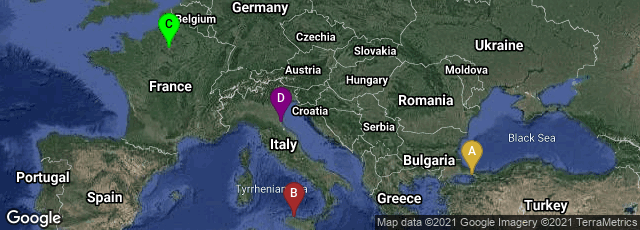Papyrus growing wild on the banks of the Nile in Uganda, by Michael Shade.

A: İstanbul, Turkey, B: Palermo, Sicilia, Italy, C: Paris, Île-de-France, France, D: Ravenna, Emilia-Romagna, Italy
"After A.D. 677 the Merovingian chancellery used only parchment, but otherwise papyrus continued in use in France at least till 787. In the ninth century the papal chancellery was still being supplied from Arab Egypt, whence the latest extant papyri bear dates equivalent to A.D. 981, and possibly 1087. A tenth-century gloss refers to the Romans in the present tense as 'customarily writing on papyrus'. An extant papyrus codex of c. A.D. 970 contains an inventory of the land holdings and leases of the Ravenna church, while a papal parchment from Ravenna bears the date of A.D. 967. From Paris come instances of older papyrus reused in the tenth and late eleventh centuries. The latest papyrus document from Spain, a papal bull on papyrus is one of Victor II dated A.D. 1057. But the papal chancellery was still using papyrus some twenty-five years later, and in Sicily and southern Italy books and documents written on papyrus are found through the eleventh and perhaps into the twelfth century. There is also evidence which, if it can be taken at face value, attests that papyrus was still in use at Constantinople as late as c. A.D. 1100. Thereafter the use of papyrus ceases altogether. The Latin word papyrus was retained to designate paper, but the writing material made from the papyrus plant passed completely out of common experience.
"It has been suggested that the papal chancelleries toward the end drew their supplies of papyrus from Sicily. This is a possible inference, though not a necessary one, for a flourishing trade in papyrus from Egypt, exporting not only to eastern cities like Baghdad but also westward as far as Spain, is attested in Arab sources at least through the tenth century. The export trade and the manufacture of papyrus received their death blow in the course of the next hundred or so years. The East turned to rag paper, made by a process obtained from the Arabs from China, the West to parchment, which been used increasingly since late antiquity. Eustathius, who wrote in Constantinople in the third quarter of the twelfth century has the final word: 'Papyrus making', he remarks, 'has lately become a lost art' " (Lewis, Papyrus in Classical Antiquity [1974] 92-94).